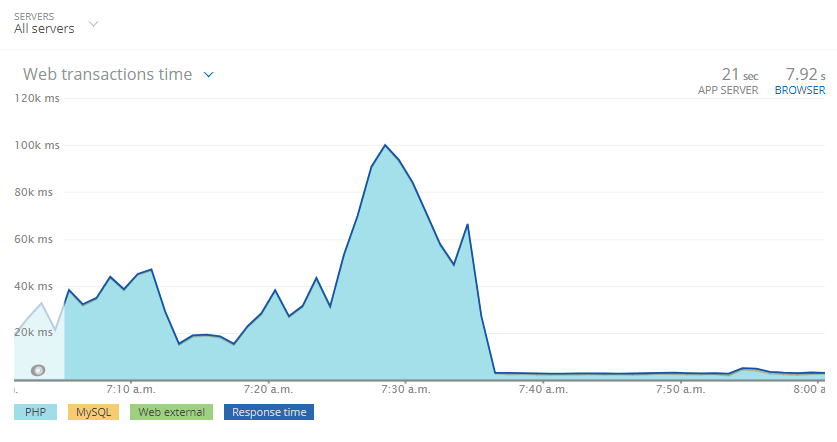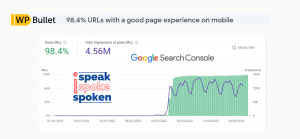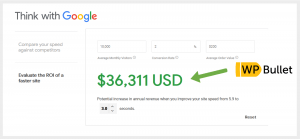Troubleshooting WordPress and WooCommerce performance issues is something we do every day. It is incredibly rewarding to stabilize a site so it can do its job: make your visitors, its owner and employees happy to use it! Major bottlenecks can be tricky to find, but with an approach of forensic analysis and clinical execution, performance can improve significantly.
Our performance troubleshooting approach follows the MAIA strategy. Coincidentally, in Roman mythology Maia was associated with the concept of growth (but we didn’t have an affair with Zeus).
Nothing helps your site and business grow more than stability and speed, all of the marketing and UX brilliance or design work cannot compensate for garbage performance.
– Monitor – measure performance data everywhere
– Analyze – collect and organize the data
– Insight – lightbulb moment of potential issue and culprit
– Action – specific action taken to address the performance problem
There are no guarantees with performance troubleshooting. It is like going to therapy, a mechanic or the doctor, results are possible with enough time and effort. Check out our performance troubleshooting case studies for real client results.
One client once said “you are like the House of website troubleshooting”. He was referring to Dr Gregory House portrayed by Hugh Laurie.
Dr House’s process is to triage your situation, run tests and look for insights and conclusions of what to try next. Similarly, we use differential diagnostics for WordPress and WooCommerce sites. Like House, we need to get a detailed history of your site and then run some tests and monitor your site. We do think our bedside manner is much better than House 😉
Ideally we will monitor the full user journey from the visitor’s browser to your host server and back to the visitor’s browser.
If we gather enough data and you are open to changing whatever it takes, you will be like a happy restaurant owner from the TV shows Restaurant Impossible or Kitchen Nightmares – or Bar Rescue!
Do You Need Performance Troubleshooting for your WordPress Site?
Are you waiting far too long to see your website’s content, like the first image or text, visually ready to enjoy in your browser?
High, slow Time to First Byte (TTFB) is one symptom you need performance troubleshooting. This client earned an extra $1 million dollars in revenue after addressing their high TTFB issues.
If your WordPress site is crashing with 502 Bad Gateway, 503 Backend Fetch failed (also Guru meditation), 504 Gateway timeout then troubleshooting is for you!
If you are using Cloudflare and getting any of these errors below you most likely need performance troubleshooting:
- 503 service temporarily unavailable
- 520 web server returns an unknown error
- 521 web server is down
- 522 connection timed out
- 523 origin unreachable
- 524 timeout occurred errors
If any of these situations below happen to your WordPress site or WooCommerce store, troubleshooting is for you!
- If your website gets randomly slow at certain points of the day and pages take a very long waiting time to load completely
- If the wp-admin dashboard area (backoffice) takes forever to load then you could benefit from performance troubleshooting
- If your website crashes when a lot of visitors come to your site
- This includes users logging in to your site for a virtual online event you are hosting
- If your website starts to lag when many users are on your site or store
- When you launch ad campaigns through Google, Facebook or email newsletters your site crashes or gets very slow
We help solve these problems every day, it is so rewarding to feel the relief from clients when their site finally is stable and performs at a respectable speed!
New Relic Signs you need Performance Troubleshooting
We are certified certified New Relic University approved certified specialists. New Relic helps us identify bottlenecks and bring WordPress sites and WooCommerce stores back to life!
Here is a screenshot from New Relic for a homeschooling site that became very popular during COVID-19 to help parents homeschool their children.
This site had an average response time of 44 seconds before we intervened, look at that processing time dropping like crazy!
Read the case study for the homeschooling site here and how we stabilized the site for countless parents and kids.
How will Performance Troubleshooting Help me?
The main benefit of performance troubleshooting is helping you identify the culprits of your slow WordPress site or WooCommerce store.
You can stop looking in the wrong places or wasting time on a wild goose chase for performance.
We provide you data and evidence showing why your site is performing poorly and/or crashing along with a plan of how we can fix it!
What You Have to Do
You tell us which pages or actions are taking forever to visually load that you hate waiting for in your browser.
We need access to your wp-admin as an Administrator.
We need access to your web host control panel and server, preferably SSH access.
We need to know how you get traffic to your site whether it is organic, via Facebook groups, Instagram, Gooogle or Facebook ads etc.
You will likely have to grant us permission to temporarily move your website so we can use all of our performance debugging tools.
Potential Outcomes and Benefits
We may have to move your site in order to use some performance monitoring tools if your host does not support them.
We measure all of the slow processes on your site and find the culprits with an action plan of how to fix them!
Increase Google Rankings – stop worrying if your crashing site is affecting your SEO efforts.
Your employees can actually work efficiently since the site stops throwing errors every time they try to log in.
Increase revenue since an unstable site can’t sell products reliably – users get frustrated and leave.
User retention usually increases because the user sees delicious content instead of error pages or white screens with no yummy content you’ve worked so hard on!
Performance Troubleshooting Phase 1 – Monitor and Audit
We gather data about your site. We have a questionnaire for you that helps us hone in on the most likely cause of your site slowness and crashes.
If necessary, we get the site onto a hosting platform with New Relic so we can start gathering useful insights.
N.B. Just because a hosting provider supports New Relic does not mean we will not have to move the site.
We will ask you lots of questions during this phase to get a better idea of what may be causing the performance issues.
You should be prepared to answer questions about why a certain feature is important and why specific plugins are used.
During this phase we may ask you if we can turn a setting off or disable a plugin temporarily to see how the site reacts.
After this phase, we provide a summary report outlining the major issues and solution plan. Often we have several solutions to 1 particular performance problem or bottleneck.
We will jump on a Zoom call to go over everything so you feel comfortable with the next phase: testing solutions!
Note that in very rare cases, if the web site is in particularly poor health, we need to get the site into a special development environment to do hardcore debugging. This hardcore debugging may be an extra cost.
Performance Troubleshooting Phase 2 – Testing Solutions
We will test any immediate fixes that could resolve the performance problem. Ideally we test potential improvements on the staging site or server. This helps us ensure we do not affect your live site before we know the fix has no unintended or unexpected consequences.
Some of the action items that we yield from the discovery phase
- Disabling a plugin
- Changing host
- Changing server configuration
- Adjusting some settings in the theme
- Adjusting some settings in plugins
- Fixing any core WordPress engine issues
- The database needs a very thorough cleaning
- Your theme must be replaced with a lighter version
- Page builder needs to be replaced or removed
- Some dynamic requests are causing the site to crash which we have to address
- Your site is under attack and we need a security plan to mitigate the attack
After this phase, we hope the site stabilizes and you can carry on business as usual after it passes the quality assurance testing.
At this stage, we will ask you to help go through the staging site and find out if everything works as expected.
If something doesn’t work as expected then we will address those issues if they are critical.
If the bugs are not critical we make an itemized list in terms of priority and tackle them after implementing the most critical fixes in the next phase.
We have quality assurance methods we can share with you and your team to help streamline the process.
Performance Troubleshooting Phase 3 – Implement Solutions
We now implement the solutions on the production site where your site gets live traffic.
We take a backup first of course!
Typically this means executing a custom script we have tailored specifically for your site.
Everything is documented as thoroughly as you want, more documentation takes longer and costs more of course.
We will then move into the aftercare monitoring phase which is often combined with solution implementation phase.
Performance Troubleshooting Phase 4 – Aftercare Monitoring
This phase is optional but highly recommended.
In this phase we actively check the site and key metrics to make sure no new issues emerge.
We standby to fix any bugs that may not have emerged during the quality assurance testing.
Generally, the entire process takes 2-3 days total from audit to testing, verifying and finally implementation. However, in emergency situations we can triage critical performance issues the same day.
We take performance troubleshooting extremely seriously and our team is very thorough so like Dr. House, given enough time and resources, we will find out what is wrong with your site!
Working Together Requirements
You should be open to changing almost anything and everything on your site to help achieve site stability and performance. This can mean changing hosting, themes, plugins, CDN, design etc. The more flexible you are, the more likely we will be able to get your site running well.
Sometimes we will have to make compromises between performance and user experience or convenience.
We will always work with you to help you keep your site’s gadgets, functionality and toys but without the performance cost.
Prepare to be collaborative, while we do most of the heavy lifting we will ask for your input to make sure we are not impacting your user experience or business goals.
The more you can help us, the more likely we are to
Common Performance Troubleshooting Pitfalls
See this post about WordPress performance optimization failing despite your attempts.
Usually when people come to us needing performance troubleshooting, there is a laundry list of things they already tried to fix the slowness.
There is no shortage of blog posts and plugins that will promise you that they have the answer. Some of them might, but until you know what the problem is, how will you ever fix it?
The art of performance troubleshooting is to dig into what the site is actually doing and measure the slow actions and processes, so we know why the site is slow. Once we know why the site is slow, we know how we can correct it.
What most users tend to do is just Google and try 50 different suggestions which can even make the performance problem worse!
It is more efficient to use the right tools to identify the problem, gather evidence and then test potential solutions. Then we can measure what changed after the site adjustments and be certain we actually identified the right problem.
You can hear how this is preferable to just throwing a bunch of hopeful solutions at unknown causes of the slow site.
It is better to know what the problems are first before trying to solve them!
If the audit shows your database is bloated you will be told which table is the problematic one. We’ll link you to tools that can help you clean it up safely along with the general procedure for doing so – note this is not a step-by-step in-depth tutorial and nothing in the audit is a step-by-step tutorial but I share links where relevant so you can do as much on your own as possible. Of course we can also clean the database for you!
If the audit shows a particular plugin is causing problems, you will get evidence on what is happening and then recommendations for a replacement. If I am not aware of a particular replacement then I will tell you how the replacement plugin should function. If such a plugin does not exist you would then have the performance requirements in case you have it custom built.
If the audit shows the theme is doing something silly I will tell you which setting it is. If the theme is overall bloated then I will tell you which replacements you should use to port your theme over to so it looks and feels the same but without the bloat!
If the host is insufficient for any reason then I will tell you exactly which options are available to you along with the pros and cons of each option.
Some themes, hosts and/or plugins are “unoptimizable” so they do have to be replaced. I want to make sure you are open to all of this before we proceed. As mentioned in the article we can’t wish for performance to be how we hope it should be. I do have extensive experience with performance and users who follow my recommendations end up very happy with the results. I hope you can become one of those clients too.
Performance Troubleshooting FAQ
> I don’t want an audit, I want you to do work! Can we just get started?
Audits are the most important work we do! Like a doctor, we cannot prescribe treatment before we have a diagnosis.
The audit is that diagnosis that is critical to building our testing and implementation plan for you, we don’t just go in blind and start testing random optimizations – that is a recipe for disaster!
> What does our audit look like?
Add snippet about audits not being simple copy pastes from google or gtmetrix. In your analysis you will get insights about what is happening band why along with recommendations on how to address the problem and verify they worked.
You know it is slow, anybody can run a site through Lighthouse. You need the why and how, that is where I come in. Implementation of solutions that fix “how’s and why’s” of perfumanxe problems get results.
Here is a sample of a performance troubleshooting report.
> Will I have to replace my theme?
Maybe! If we can fix the existing theme then you can keep it but this may not be possible.
We will happily submit performance bug reports to developers for them to fix. It is up to them to address them.
In some cases, the developers of your problematic theme can hire us by sending them this link.
> Will I have to get rid of some plugins?
It’s a strong possibility, but we will help you find performance-friendly alternative or custom build ones for you. We always work with you to compromise on the features of your site without the performance cost.
> What if the bottleneck is a critical plugin for my site?
We will document the issue and outline how it should be fixed by the developers who built the plugin. We’ll provide a script for the email you can send to the plugin support.
If it is a custom plugin then we can fix it for you and document the changes and reasoning behind the update. We’ll provide performance metrics for this where relevant.
> Will I have to change host?
Probably, most hosts are not well-tuned for performance unfortunately despite any marketing claims or blog posts you’ve read.
> Will you tell me what you fixed?
We provide whatever level of documentation you like – we actually love documenting! The more thorough the documentation the higher the cost but if you have a basic changelog document like this one we can add the changes there.
> What is the worst possible outcome of performance troubleshooting?
If your site was made with performance-unfriendly parts then it may have to be rebuilt using performance-friendly components. This is the worst kind of news to give and is the least favorite part of this job – rest assured there is hope and we will guide you towards the version that doesn’t suck for performance!




